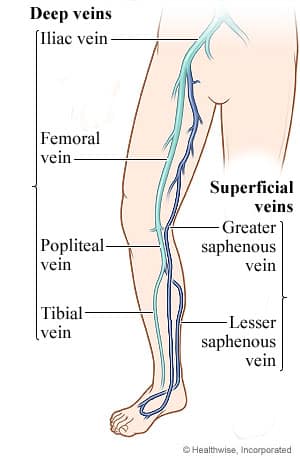Phlebitis means inflammation of a vein. This is a general term, and when used without a prefix, describes an irritated or tender vein. Simply put, a vein that hurts.
The most common cause of phlebitis is reflux or backward blood flow in veins. The mechanism that leads to the inflammation in a refluxing vein is congestion; the pressure of blood not being able to empty or circulate through the veins. This congestion and irritation lead to an increase of inflammatory cells around the vein wall, causing severe discomfort. The other common cause of phlebitis is a clot in the vein, called thrombophlebitis.
Tenderness in veins caused by reflux is usually relieved by elevation of legs above the level of the heart to allow gravity to assist the circulation instead of combating it.
Where Does Phlebitis Occur?
Phlebitis can occur in both the surface (superficial) and deep veins.
Deep vein thrombophlebitis affects the larger blood vessels deep in the legs. Blood clots (thrombi) can form, which may break off and travel to the lungs,resulting in a pulmonary embolism. This is a serious medical condition that requires immediate cardiovascular treatment with blood thinning medications. See deep vein thrombophlebitis on the next page for a more detailed account of this potentially fatal condition.
Superficial phlebitis affects veins on the skin surface. The condition is rarely serious and, with proper care, usually resolves rapidly. Occasionally, people with superficial phlebitis also develop deep vein thrombophlebitis, so a medical evaluation is necessary.
Treatment of superficial phlebitis caused by venous reflux or other underlying causes begins with simple conservative measures that can be done at home.

How Can Phlebitis Be Prevented?
Prevention is always the first step. Being active (walking, avoiding prolonged periods of sitting or lying down if possible) will increase blood flow and prevent blood from pooling into a clot.
Avoid bed rest for prolonged periods of time as it can make symptoms worse.
- Ibuprofen, an anti-inflammatory medication may help lessen inflammation and the associated pain
- Prescription leg compression stockings (knee or thigh high) improve blood flow and may help to relieve pain and swelling.
- If these measures do not give adequate relief, treatment of the underlying reflux may be necessary. The recommended treatment to eliminate venous reflux is an Endovenous Laser Treatment